Related Research Articles
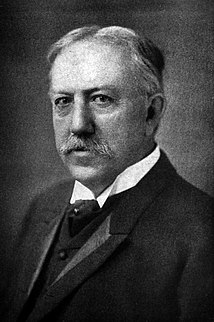
David Starr Jordan was the founding president of Stanford University. A leading ichthyologist and eugenicist of his day, he had previously been president of Indiana University. He was an antimilitarist who initially opposed U.S. involvement in World War I.

George Brown Goode, was an American ichthyologist and museum administrator. He graduated from Wesleyan University and studied at Harvard University.

The yellowfin cutthroat trout is an extinct subspecies or variety of the cutthroat trout, a North American freshwater fish.
Barton Warren Evermann was an American ichthyologist.
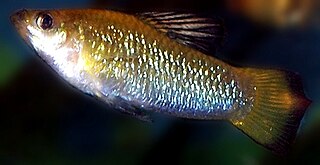
Perugia's limia is a small fish of the family Poeciliidae endemic to the Dominican Republic where it occurs in streams. This species grows to a length of 10 centimetres (3.9 in) TL. This species was Species description described as Platypoecilus perugiae in 1906 by Barton Warren Evermann and Howard Walton Clark with a type locality given as a small stream in the San Francisco Mountains of the Dominican Republic. The specific name honours the Italian ichthyologist Albert Perugia (1847-1897) of the Museo Civico di Storia Naturale di Genova in recognition of his work on West Indian fishes.
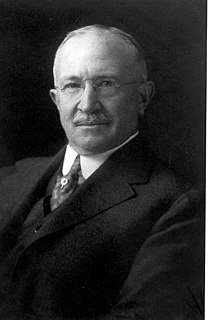
Charles Henry Gilbert was a pioneer ichthyologist and fishery biologist of particular significance to natural history of the western United States. He collected and studied fishes from Central America north to Alaska and described many new species. Later he became an expert on Pacific salmon and was a noted conservationist of the Pacific Northwest. He is considered by many as the intellectual founder of American fisheries biology. He was one of the 22 "pioneer professors" of Stanford University.
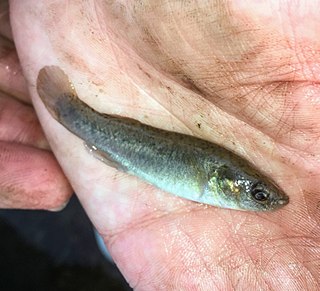
The saltmarsh topminnow is a species of killifish for the family Fundulidae. It occurs in the costal wetlands of the Gulf of Mexico in the United States.

Zoramia gilberti is a Cardinalfish from the Western Central Pacific. It occasionally makes its way into the aquarium trade. It grows to a size of 4.2 cm in length. It is found in sheltered bays and lagoons, where it gathers in large aggregations among branching corals, frequently mixed with other cardinalfish species. The specific name honours the American ichthyologist and fisheries biologist Charles H. Gilbert (1859-1928) of Stanford University who was a colleague of Jordan's.
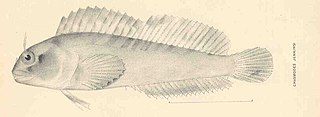
Hypsoblennius jenkinsi, the mussel blenny, is a species of combtooth blenny found in the eastern central Pacific ocean. This species grows to a length of 13 centimetres (5.1 in) TL. The specific name honours Oliver Peebles Jenkins (1850-1935), who was professor of physiology at Stanford University.
Labrisomus jenkinsi, Jenkin's blenny, is a species of labrisomid blenny endemic to the Galapagos Islands where it seems to inhabit areas with rocky substrates. This species can reach a length of 13 centimetres (5.1 in) TL. The specific name honours Oliver Peebles Jenkins (1850-1935), who was a professor of physiology at Stanford University.
Metzia is a genus of cyprinid fish that is found in eastern Asia. The genus is named in honor of the American ichthyologist Charles William Metz of Stanford University.

Mugil thoburni, Thoburn's mullet, is a species of grey mullet, from the family Mugilidae, found in the eastern Pacific Ocean. It is most common around the Galapagos Islands but does occur on the coasts of Central America and South America as well. This species grows to a length of 29.5 centimetres (11.6 in) TL. It was formerly regarded as the only known member of the genus Xenomugil.
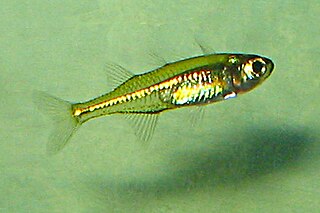
Alepidomus evermanni is a freshwater species of silverside endemic to western Cuba. This species grows to 3.3 cm (1.3 in) in standard length. It is the only known member of its genus. This species was described as Atherina evermanni by Carl H. Eigenmann in 1903 with a type locality of San Cristobal, Cuba. The specific name honours the American ichthyologist Barton Warren Evermann (1853-1932).

Fowleria is a genus of fishes in the family Apogonidae native to the Indian and Pacific Oceans. The name of this genus honors the American ichthyologist Henry Weed Fowler ( ) of the Academy of Natural Sciences of Philadelphia, who attended Stanford University, where he was a student of David Starr Jordan's.
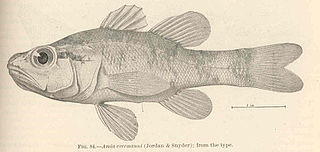
Zapogon evermanni, Evermann's cardinalfish, is a species of cardinalfish native to tropical reefs in the Indian and Pacific Oceans and the western Atlantic Ocean.

Evermannia is a genus of gobies native to the eastern central Pacific Ocean coast of the Americas from Baja California to Panama. The genus name honours the American ichthyologist Barton Warren Evermann (1853-1932).

Kelloggella is a genus of fish in the family Gobiidae, the gobies. This genus is distributed in the Indian and Pacific Oceans. The genus name honours the American entomologist Vernon Lyman Kellogg (1867-1937) of Stanford University, the discoverer of Kelloggella cardinalis.

Charles Harvey Bollman (1868–1889) was an American naturalist who published on fishes and myriapods, becoming known internationally for his work in a short career before dying at the age of 20, considered by David Starr Jordan one of the most brilliant and promising naturalists he had ever known.

Charles Lincoln Edwards (1863–1937) was an American zoologist. His research included studies of development in reptiles and sea cucumbers, chromosomes of Ascaris roundworms, and taxonomy of sea cucumbers and copepods, naming at least five species of copepods found in sea cucumber body cavities.
McCulloch's hardyhead is a species of silverside from the family Atherionidae. This species occurs off the coasts of Australia. It was described by David Starr Jordan and Carl Leavitt Hubbs in 1919 from a type locality of Lord Howe Island and the specific name honours the Australian ichthyologist Allan Riverstone McCulloch (1885-1925), who was Curator of Fishes at the Australian Museum and who provided Jordan and Hubbs with the type.
References
- 1 2 3 Amos W. Butler. "A View of Oliver Peebles Jenkins". Indiana University – Purdue University Indianapolis . Retrieved 10 March 2019.
- ↑ "Report on collections of fishes made in the Hawaiian Islands, with descriptions of new species". U.S. Govt. Print. Off. 1903. Retrieved 10 March 2019.
- ↑ Christopher Scharpf; Kenneth J. Lazara (26 October 2018). "Order BLENNIIFORMES: Family BLENNIIDAE". The ETYFish Project Fish Name Etymology Database. Christopher Scharpf and Kenneth J. Lazara. Retrieved 10 March 2019.